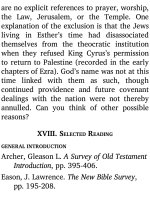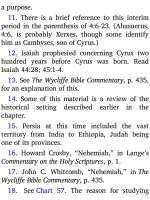Jensens survey of the old testament adam 159
Bạn đang xem bản rút gọn của tài liệu. Xem và tải ngay bản đầy đủ của tài liệu tại đây (151.93 KB, 4 trang )
16
Psalms: “Bless the Lord, O My Soul”
Psalms is one of the most practical books
of the Bible, wondrously suited to the
human heart. It is especially dear to every
child of God, perhaps because there is no
experience of the believer which does not
nd its counterpart in the Psalms. Someone,
in speaking of the whole Bible as “the
Temple of Truth” and the di erent books as
di erent rooms of that temple, has called
Psalms “The Music Room.” It is lled with
heavenly music suited to man’s every
experience. Here the Holy Spirit sweeps
every chord of human nature: from the low,
wailing note of Psalm 51, to the high,
exultant note of Psalm 24. That Psalms was
a favorite book of the rst-century believers
is shown by the fact that of the New
Testament’s 283 direct quotations from the
Old Testament, 116 are from Psalms.
I. PREPARATION FOR STUDY
1. Be acquainted with the various literary
devices used by the authors of poetic
writing. Some of the main ones are:
a) Simile: comparison of two things, usually
employing the words as or like (e.g., “He
will be like a tree,” Psalm 1:3).
b) Metaphor: comparison of two things
without using the words as or like (e.g.,
“The LORD is a sun and shield,” Psalm
84:11).
c) Hyperbole: exaggeration for effect (e.g.,
“Every night I make my bed swim, I
dissolve my couch with my tears,” Psalm
6:6).
d) Personification: applying personality
traits to inanimate objects (e.g., “All my
bones will say, ‘Lord, who is like Thee,’”
Psalm 35:10).
e) Apostrophe: addressing inanimate things
(e.g., “What ails you, O sea, that you
flee?” Psalm 114:5).
f) Synecdoche: representing the whole by a
part, or a part by the whole (e.g., “the
arrow that flies by day,” Psalm 91:5).
2. Praise and prayer are keynotes of the
psalms. Before surveying the book, think
much about what is genuine praise and what
is genuine prayer.
II. BACKGROUND
A. NAME
When the individual lyrics of David and
the other authors were brought together as
one anthology, possibly as early as 500 B.C.,
the Hebrew title given to the anthology was
Tehillim, meaning “praise songs.” The Greek
Septuagint translators gave the title Psalmoi,
meaning “songs to the accompaniment of a
stringed instrument,” and this was the Greek
title used in the days of Jesus (read Acts
1:20). Thus, our English title Psalms is really
an ancient title, even in pronunciation. The
t e r m Psalter, by which this book is
sometimes called, is derived almost letter
for letter from the Greek word for “stringed
instrument.”
B. PLACE IN THE BIBLE
In the Hebrew Scriptures the scroll of
Psalms appeared at the beginning of the
third division called “Writings.” (Recall the
three divisions of the Hebrew Bible as Law,
Prophets, and Writings; cf. Luke 24:44.) As
such, this collection of sacred songs was the
inspired prayer and praise book of the
nation of Israel. In the fourfold grouping of









